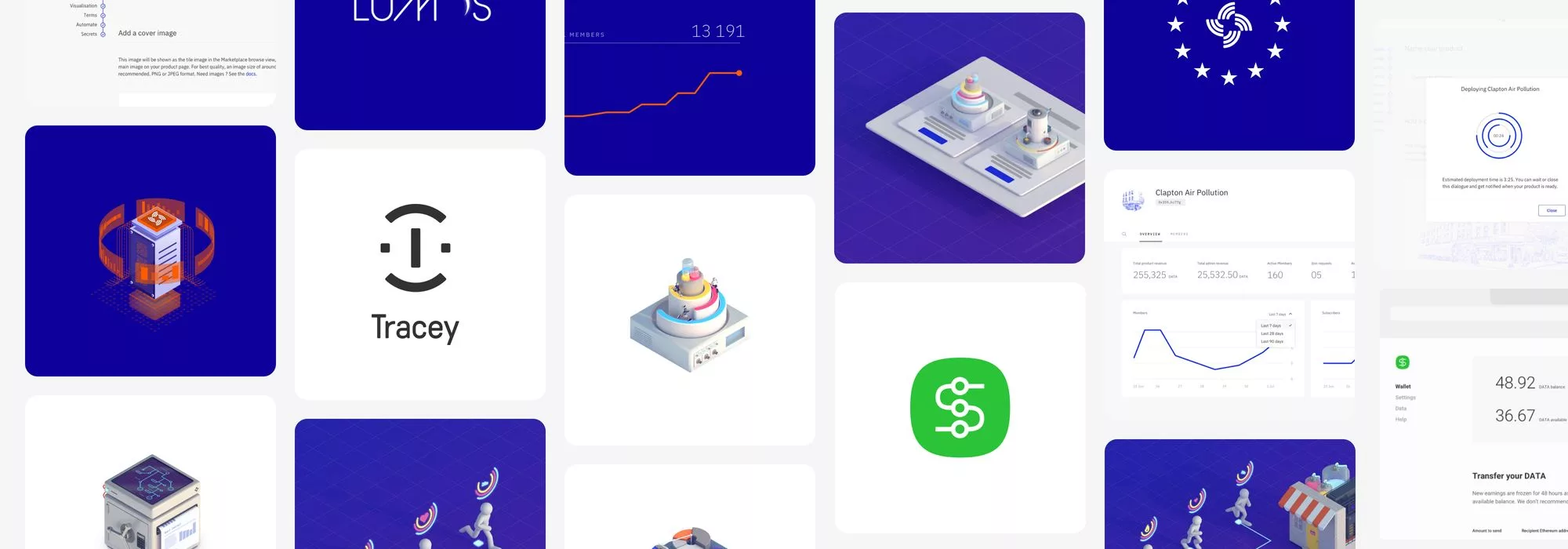As the launch of the Data Unions 2.0 framework draws near we thought we’d do a roundup of all that has happened on the Data Union front for the last 12 months.
This time last year, just as the lockdown was about to hit a good proportion of countries around the globe, Streamr settled on its annual strategy. We would build out the Data Union ecosystem whilst continuing to work away at our main vision: a P2P pub/sub Network for real-time messaging. There were two major business reasons for this. The first was: Data Unions utilise the Network, and thus provide serious early adoption. The second reason was: Data Unions in and of themselves are a worthy endeavour for Streamr to pursue as a way to change up the global data economy. How do Data Unions do this? By allowing data from potentially hundreds of millions of people to be bought and sold within a far more solid consensual trading framework (i.e. share data and earn revenue). Effectively Streamr is attempting to port Web2 data into the Web3 space, turning the largest digitally native product on the planet – information – into a Web3 asset to be bought, sold and even financialised.
It’s a big vision. Here’s what we achieved so far:
Table of Contents
Laying The Groundwork
Product Development
Without the software, there’d be nothing for Data Union operators to build on, so getting this right was obviously key. Though an MVP version of the framework had been available through 2020, the beta launch went live in June providing a GUI for builders through the Streamr Core app. In October, we finally went fully live and pushed out our marketing efforts with the public launch of Data Unions 1.0.
The GUI through the Core app also provided a certain level of sandboxing for builders. And now, Data Unions 2.0 is a week away from release. It’s a very different beast. Instead of Streamr running a server to maintain the Data Union backend, the smart contracts which split revenue between members and operators, and manages member joins, will be on the Ethereum Mainnet with a sidechain providing a scalable means to make those payments. Smart contract audits are complete and the frontend team is exercising 2.0 functionality with the JavaScript client.
The final hurdle, as Matthew Fontana Streamr’s new Head of Ecosystem says, is the bridge allowing members to exit Data Union payments from Ethereum mainnet. Launching on the xDai chain is what the dev team has opted for.
Developer Resources
Before onboarding to the Data Union stack could begin we also had to ensure that the requisite resources were in place. Creating dev docs, video tutorials, a new data union product creation flow and other useful materials such as blogs and a dedicated web page took up most of the summer.
Grants
The third part of laying the groundwork for success was setting up a more streamlined grants system. In 2019, our grants system was run by part-time community members. Last year we took most of that work in house to speed up and professionalise the process; bringing the funding and those aiding the development within Streamr, closer together. We’ve now issued over 30% of our grants from our pool of 10M $DATA – many of which have gone to Data Union builders, and with a reworked web page, developers have a much clearer route to applying to those grants.
Building external networks
The final part to laying the groundwork for Data Unions’ success was ensuring that external players from business, academia, and policy activism knew Streamr’s mission and could help guide us to make further connections.
Setting up our advisory board with some real practitioners and thinkers such as the Data City’s Alex Craven, Radical Exchange’s CEO Matt Prewitt, Sussex University’s Maria Savona, and The Data Union’s President James Felton Keith’s was a crucial first step. They have all been massively helpful in pointing out problems, spreading our message, making connections, and aiding Data Unions like Swash by giving guidance on everything, from data structuring for buyers to marketing, messaging and ethics.
We also joined the My Data Global network and registered as an operator ourselves, though strictly, we are infrastructure builders for operators. This has given us access to other builders in the space which we hope in time will lead to more Data Unions being built on the Streamr stack. At the end of last year, we were the gold sponsor of their annual global conference.
Ecosystem growth
Start up Builders
Last year the majority of our internal developer firepower went towards getting our small startup Data Union builders both interested in the stack and then off the ground. Work slowed over the summer as we waited to on-board a new someone to head up developer relations and ecosystem growth, an internal pick: Matthew Fontana. In the last few months this work has expanded again and to date there have been some wins and losses.
Swash is the most developed of all the Data Unions built on the Streamr stack. As committed Streamr members will know, it’s a plugin that functions on all major browsers, including Chrome and Firefox, collecting rich seams of web browsing information from members in order to monetise it on their behalf.
Ebrahim Khalilzadeh, lead developer for Swash, began his Data Union journey back in Feb 2019 and it has been remarkable watching his progress:
- Swash membership has grown 10x in a year, crossing the 10,000+ member mark a few weeks back.
- He’s built out a team of four developers, hired a CEO and CMO brought in a handful of advisors.
- Swash was selected by Outlier Ventures for their start up program
- They started selling their data on Streamr and the Ocean Market data marketplace, where their products have more than €300,000 in staked value.
Swash and now looking towards a first serious round of funding.
Xolo is the working title for a project that collects health data from integrations with high end Withings smart watches. It is at the prototyping stage and is now looking to onboard its first test users and work to refine its data product offering.
Unbanks is a project being built by devs with a background in banking, real-time data and application development. Registered as a PSD2 company under open banking regulation, Unbanks will be able to read the banking transaction data of its members and help monetise that on their behalf. It has a lot of potential.
MyDiem has now been siloed because Gang, who was leading the development from China, had to return back to his PhD. The mobile app, which collects information on how members use other apps on their phone, is now open sourced and waiting for an intrepid team to take it over for development.
Partnering with Lumos Labs, we also launched a hackathon in India to get Data Union ideas off the ground and tested. It was quite exciting to see all of the new ideas being built on the framework. The top five teams presented at the Demo Day on Saturday for a chance to win a $5,000 grant. A roundup of the hackathon is coming soon!
Enterprise outreach
Work on the enterprise front began a year ago. The idea here was that we could get large businesses to remodel the way they permission data and then more easily monetise it by adopting the Data Union share and earn framework.
The industry vertical we chose to target was telecoms because mobile network operators (MNOs), most especially in Europe, have access to a lot of backend data and the potential to access far more through frontend apps. But currently they find the regulatory consent, and privacy hurdles very difficult to overcome. Towards that goal, we partnered with GSMA –the consortium at the heart of the mobile industry.
With GSMA’s help we devised a programme that MNOs could pay a fee to join. The programme would last four months within which we would build out a pilot app and undertake market research with their users to test the feasibility of creating a MNO-operated Data Union. It was an exciting idea and one that GSMA was eager to promote to their membership. We set ourselves a tight deadline for MNO onboarding so as not to overrun on costs at our end.
Although we had several meetings with MNOs at the highest level – including CEOs – we ultimately ran out of time to onboard them. As well, lockdown made the sort of in-person meetings where trust can be built, impossible. Furthermore, GSMA underwent an internal reorganisation due to the fact that a major source of their income –Mobile World Conference – had to be cancelled twice in a row. In hindsight, we would have given ourselves more time to onboard MNOs. But another stumbling block was the use of crypto to distribute payments, something which of course is a vital piece of technology in order to distribute small amounts of value to multiple members. Big enterprises aren’t yet ready from a legal standpoint to embrace crypto but that of course is changing every month.
Data Unions marketing and messaging:
We’ve had some great marketing and PR wins:
- Academics, policy makers and activists, including one of the world’s foremost computer scientists are now talking about Data Unions.
- 120,000 hits now on Google for the phrase “Data Union” – Streamr is at the top.
- 82 press mentions in 2020 including Yahoo Finance, BBC, Coindesk, the FT, Cointelegraph, Forbes and Harvard Business Review
- 25 conference appearances despite the pandemic
- Several online meetups as part of the Hackathon and lots of community AMAs
- Social media engagement, including hit tweets, and 47k views on the Data Union Youtube video.
Really loved chatting about Data Unions with Gareth and the @digitalplanet team on the @bbcworldservice And it was so great you all kept talking about it afterwards! #data https://t.co/JON89a733m
— Shiv Malik (@shivmalik) October 6, 2020
Lobbying
Perhaps our biggest standout success this year was Europe embracing Data Unions in the form of new legislation and grants. In November, the European Commission released the draft of the Data Governance Act that sets out a licensing and regulatory framework for data unions – or data intermediaries as they call them – which will give this nascent sector a huge boost in terms of funding, trust, stability and assurance and advertising a direction of travel to the world. They have also announced that €2bn in funding will be made available for those seeking out to build enabling software and Data Union projects.
If that was not enough, then a second piece of EU legislation, the Digital Markets Act will also unlock user data from the big tech companies like never before. As currently drafted, the act seeks to establish realtime portability rights for users of ‘gatekeeper’ platforms. Should this provision pass into law, this means that Data Union operators will be able to utilise streams of information from iTunes, Amazon and Google etc, and onboarding to Data Unions will happen in a comparative flash with access to user information coming through APIs,not through a plugin or secondary application.
After nearly a year-and-a-half of lobbying by Streamr and our friends in RadicalxChange and MyData Global, these regulatory changes are an extraordinary win. With the EU backing Data Unions, drawing up new rules, providing money, and also permitting far more data from the big Silicon Valley gatekeepers to come on board, it really is just a matter of time before even more versions of Data Unions come online and start succeeding in a big way.
Where is this all going?
It’s hard to doubt the potential for success. Other web and mobile Data Unions like GeoDB, Panel App, TapMyData and MobileXpression already have millions of users between them, who earn income from filling in surveys, or permitting their browsing or location data to be read and monetised in a privacy-protecting manner.
Data Union operators have also organised themselves into a lobbying, information sharing, and standard setting ecosystem under the MyData Global banner. That organisation counts nearly 30 projects as builders of these new, user focused, data organisations and over 100 associate member bodies.
But the real insight here might be that Data Unions are acting as a bridge between Web2 and Web3, helping to convert data from the tech giants into Web3 assets. If we can pull this off, it’ll be a huge victory. Not just for ordinary people who will obviously benefit from the remuneration of the data but also from secondary innovation based on data sets that are no longer siloed. This will also be a massive win for the Web3 space, as the largest digitally native asset in the world – information – floods into the space and starts to get traded and even financialised.
We’re excited to be a part of this and can’t wait to see what the rest of 2021 holds in store. Feel free to leave any questions for me in the #data-unions channel on Discord. I’ll be running a Data Unions AMA on Thursday 18th March at 13:30 UTC, so I look forward to seeing you there.
Learn more about Data Unions
- Discover Data Unions
- Documentation: Intro to Data Unions
- Data Union DAO










